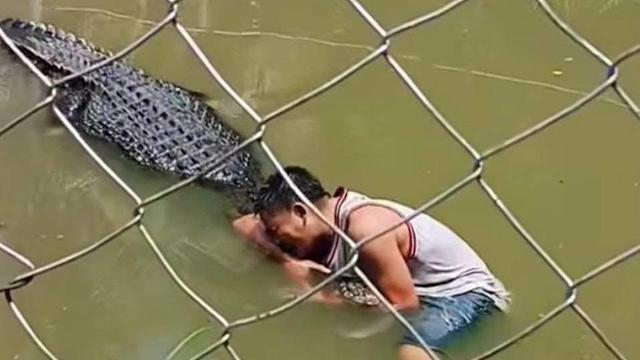NOTE:VIDEO AT THE END OF ARTICLE.
Tourist’s Selfie Attempt Leads to Brutal Crocodile Attack: A Cautionary Tale of Zoo Safety and Animal Enclosure Hazards
A tourist visiting a zoo in the Philippines recently found himself at the center of a terrifying ordeal after mistakenly attempting to take a selfie with a crocodile, only to be violently attacked by the animal. This incident has sparked widespread concern about the safety protocols in place at zoos and animal parks, and serves as a stark reminder of the dangers of interacting with wild animals, particularly in captivity. The 29-year-old man’s decision to climb into a crocodile enclosure, believing the reptile to be a stationary statue, resulted in severe injuries and a dramatic rescue.
The Disturbing Incident at Kabug Mangrove Park and Wetlands Zoo
The terrifying events unfolded on April 28, 2025, at the Kabug Mangrove Park and Wetlands zoo, a popular attraction in the Philippines known for its diverse array of wildlife. The tourist, whose identity has not been disclosed, was reportedly wandering through the zoo when he encountered a crocodile named Lalay, a 15-foot-long reptile housed in an enclosure designed to showcase its imposing presence.
According to onlookers, the man, who had been exploring the zoo with no apparent intent of interacting with the animals, spotted the crocodile and, under the misconception that it was a life-size statue, decided to get closer. It’s believed that the stillness of the crocodile, which remained unmoving, led the tourist to believe it was a static display rather than a living, breathing predator. In his quest for the perfect selfie, the man scaled the fence surrounding the enclosure and waded through the shallow water to approach the crocodile.
The Attack: A Fight for Survival
As the man closed in on the crocodile, an unexpected and brutal attack occurred. Lalay, who had been lying motionless, suddenly sprang into action, snapping her powerful jaws around the tourist’s arm. The man screamed in agony as the crocodile’s sharp teeth sank into his flesh, but this was only the beginning of his terrifying ordeal.
As the man attempted to escape, Lalay clamped down further, her jaws moving from his arm to his thigh. With incredible force, the crocodile began executing the dreaded “death roll,” a behavior exhibited by crocodiles in the wild when they subdue prey. This roll is designed to tear apart its victim, and it left the tourist at the mercy of the reptile.
Despite his screams and attempts to escape, Lalay refused to release her grip. The onlookers, horrified by the unfolding scene, shouted at the man to get out of the enclosure, but their warnings went unheeded. The man, trapped in the enclosure with the crocodile, continued to be dragged and flipped in a violent motion as the crocodile’s hold tightened.
The Rescue Effort: A Narrow Escape
The incident continued for an agonizing 30 minutes, with the tourist helplessly trapped in the enclosure. His fate seemed uncertain until a zoo handler arrived at the scene. Acting quickly and decisively, the handler used a piece of cement to strike Lalay on the head, temporarily stunning the crocodile long enough to free the tourist from her deadly grip.
Following the rescue, the injured man was immediately given medical treatment by the zoo’s staff. He had suffered multiple bite wounds, including deep lacerations to his arm and thigh. The severity of his injuries required him to be rushed to the hospital, where he received over 50 stitches to close the wounds inflicted by the crocodile’s vicious attack.
The Aftermath: A Sobering Reflection on Zoo Safety and Human Error
The zoo incident has left many people grappling with a mix of relief and disbelief. Staff Sergeant Joel Sajolga of the Siay Municipal Police released a statement expressing concern about the tourist’s actions, emphasizing that entering animal enclosures is both reckless and dangerous.
“The tourist was walking around the area, then he saw the crocodile, which he thought was just a plastic fixture. He climbed the fence and entered the enclosure, and the crocodile attacked him,” said Sajolga in the statement. “This kind of behavior is very dangerous. Nobody should ever enter an animal’s enclosure at the zoo. He put other people’s lives at risk and he is very lucky to have survived.”
The police also noted that there were several zookeepers present during the incident, but they did not intervene in time to stop the man from scaling the fence and entering the enclosure. The onlookers who witnessed the reckless stunt expressed both relief and confusion. Many of them were glad that the man survived but were baffled by his decision to risk his life for a selfie with an animal known for its aggressive nature.
The Role of Zookeepers and Safety Protocols
The incident at Kabug Mangrove Park raises important questions about zoo safety protocols, particularly regarding enclosures housing dangerous animals. While it is clear that the tourist’s actions were an example of poor judgment, it also highlights potential areas where zoos could strengthen their security and safety measures to prevent such incidents from occurring in the future.
Experts in zoo management have pointed out that, while zoos typically have fences and barriers in place to prevent human-animal interactions, additional safeguards could be considered to protect both the public and the animals. In this case, it is unclear whether the fence surrounding the crocodile’s enclosure was appropriately secure or if additional signage and warnings were in place to educate visitors about the risks of interacting with wild animals.
According to animal behaviorists and wildlife safety experts, it is essential for zoos to not only provide clear and visible warnings but also to ensure that enclosures for dangerous animals are designed to be escape-proof. Furthermore, staff should be adequately trained to manage such situations quickly and effectively in case a visitor attempts to breach an enclosure.
Public Reaction and Media Coverage
The incident has drawn considerable media attention, with footage of the attack circulating online. Onlookers at the zoo, some of whom recorded the incident, expressed both horror and disbelief at what they had witnessed. One local, Canete Jie, commented, “We are glad the man is alive and that the crocodile just let him go. His legs weren’t broken, and we’re thankful for that.”
However, there has been widespread criticism of the tourist’s decision to climb into the enclosure, with many questioning why he would risk his life for the sake of a selfie. Experts on social media and in the news have pointed out the increasing trend of reckless behavior exhibited by tourists seeking attention-grabbing photos, particularly in animal parks and zoos. This behavior, often fueled by social media culture, places both visitors and animals at risk.
The Dangers of Selfie Culture: A Growing Concern
In recent years, incidents like the one at Kabug Mangrove Park have become more frequent, as the growing obsession with selfies and social media fame has led some individuals to engage in increasingly dangerous behavior. While taking photos with wild animals may seem harmless, the reality is that many animals in captivity, such as crocodiles, tigers, and lions, are highly territorial and unpredictable.
Experts have voiced concern over the dangers posed by the trend of attempting selfies with wild animals, stressing that animals in captivity are not domesticated and should not be approached in this way. The consequences of such behavior can be severe, as demonstrated in the case of the Filipino tourist. In some instances, individuals who attempt to interact with wild animals for photos have suffered life-threatening injuries or have even been killed.
A Wake-Up Call for Zoos and Visitors Alike
The crocodile attack at Kabug Mangrove Park serves as a sobering reminder of the dangers of interacting with wild animals, both in captivity and in the wild. It highlights the need for stricter safety protocols at animal parks and zoos, as well as increased public education on the risks of reckless behavior in such environments.
It is crucial for zoos to strike a balance between providing educational and enjoyable experiences for visitors while maintaining the safety of both humans and animals. This includes not only ensuring secure enclosures but also offering clear and consistent warnings about the dangers posed by certain animals, particularly those that are known to be dangerous.
For visitors, this incident underscores the importance of respecting wildlife and adhering to safety guidelines when visiting animal parks. Taking selfies with wild animals, especially those known for their aggression, is not only dangerous but also irresponsible. The tourist in this case was fortunate to survive, but others may not be so lucky.
Conclusion: Ensuring a Safer Future for Zoos and Wildlife Parks
The shocking attack by a crocodile in the Philippines offers a cautionary tale for both zoos and visitors. While the tourist’s actions were reckless, the incident raises critical questions about the responsibilities of zoos to safeguard both human visitors and the animals in their care. In the face of an increasing trend of dangerous selfie-taking, zoos must be proactive in ensuring that their enclosures are secure and that visitors are well-informed about the risks involved in interacting with wild animals. At the same time, visitors must exercise common sense and respect for the creatures they encounter, remembering that their safety—and that of the animals—depends on careful behavior and awareness.
As the debate over zoo safety continues, the Kabug Mangrove Park crocodile attack is a stark reminder that, when it comes to wildlife, one moment of recklessness can lead to life-altering consequences.

Sophia Rivers is an experienced News Content Editor with a sharp eye for detail and a passion for delivering accurate and engaging news stories. At TheArchivists, she specializes in curating, editing, and presenting news content that informs and resonates with a global audience.
Sophia holds a degree in Journalism from the University of Toronto, where she developed her skills in news reporting, media ethics, and digital journalism. Her expertise lies in identifying key stories, crafting compelling narratives, and ensuring journalistic integrity in every piece she edits.
Known for her precision and dedication to the truth, Sophia thrives in the fast-paced world of news editing. At TheArchivists, she focuses on producing high-quality news content that keeps readers informed while maintaining a balanced and insightful perspective.
With a commitment to delivering impactful journalism, Sophia is passionate about bringing clarity to complex issues and amplifying voices that matter. Her work reflects her belief in the power of news to shape conversations and inspire change.
